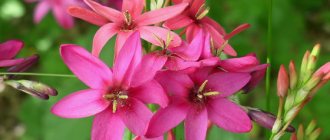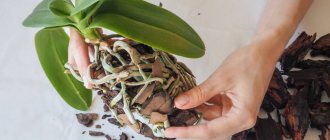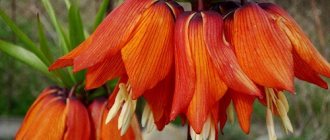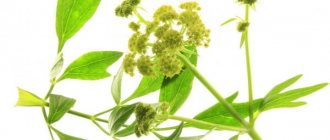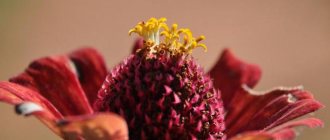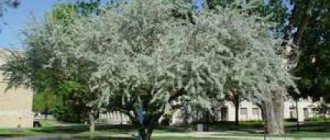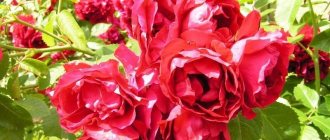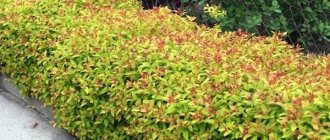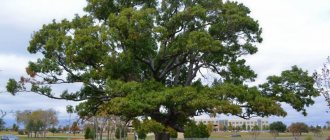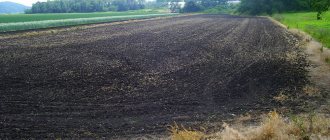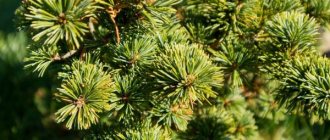The perennial plant ash tree, popularly known under the poetic name “burning bush,” is a rather exotic crop that requires care and attention. Dictumnus bushes (this is the scientific name of this plant) can ignite from open fire and can also leave a burn on the skin. Many gardeners agree to put up with such a danger and do not deny themselves the pleasure of having at least one plant, taking the necessary precautions for this.
Spectacular and dangerous - description of the dictamnus ash tree
Ash tree grows everywhere in Europe and in temperate regions of Asia. The plant has a straight but bushy trunk and is capable of creating entire thickets. Dictamnus received its well-known popular name - the burning bush - for its ability to flare up from the presence of an open fire on hot days. This plant can leave quite noticeable chemical burns on human skin.
The ability to cause a burn and burn is inherent in ash not for reasons of a supernatural nature. Everything is explained quite simply - in the heat, the plant releases a large amount of essential oils - flammable and irritating to skin receptors. It was the self-ignition of essential oil, quite possible in hot climates, that gave the basis to the biblical legend of the burning bush.
How the ash tree burns photo
However, there is no need to fear that this feature will cause a fire. After all, the combustion temperature of essential oil is not sufficient to harm the plants in the neighborhood. However, certain safety rules should still be followed.
The genus of these plants is small; previously only six representatives were identified. They are all similar in structure and appearance, and differ in aesthetic appeal, especially during flowering. This is what attracts the attention of gardeners around the world to them.
Garden ash
Ash tree dictamnus in landscape design photo
Today, all forms of ash are united by botanists under one name - dictamnus alba.
It is a tall perennial plant growing up to one meter in height. The shoots are straight, covered with edges, the rhizome is developed and powerful. The shoots harmonize well with the leaves sitting on long stems. The basal leaves are entire, the stem leaves are odd-pinnate, resembling the shape of ash greens. The foliage is very fresh and has a distinct juicy green color. Even in very hot weather, the ash tree looks as if it has just been watered - fresh and juicy. The rather sharp shape of the leaf harmonizes perfectly with the delicate color of the plant.
Video about the poisonous ash plant:
The color of dictamnus attracts attention with its original color and shape. The flowers reach 2.5 centimeters in diameter and are pale pink or white in color. The petals are pointed in shape, the stamens are graceful, light green, or, less commonly, yellowish in color. The inflorescences reach twenty centimeters in length. They are not particularly magnificent, but are usually large and graceful in shape. The veins on the petals are clearly visible, which adds elegance to the flower.
The plant has a strong odor that it emits during the flowering period. The aroma of ash, bitter-spicy and reminiscent of dried zest, is very recognizable, but some may find it too intrusive.
The main garden forms of the plant common in our country are pink or dark red. The flowers of the plant are either white or pink. Largely due to the presence of veins of a darker color, pink petals always have very interesting and varied shades. It is almost impossible to find two ash bushes that have the same color, which only adds to the attractiveness of the garden ensemble of bushes of this plant
Flowering of ash begins in June and continues for one and a half months. There are also flowerless forms of the plant, which resemble the stem structure and color of magnolia. They are suitable for people who cannot stand the peculiar smell of blooming ash.
General information
Ash trees can create colorful thickets. The plant grows upright, but since it is a perennial, it gradually increases its growth. What names were they given to him! And unbridled star anise, ash, and also the burning bush. This culture deservedly received any nickname for its inimitable charm.
In hot weather, if you bring a flame to it, the plant can burst into flames with a very bright and hot fire. And on human skin this plant may well leave almost the same types of burns as fire. Almost everyone associates this plant with the biblical story of the spontaneously combusting bush.
There is no need to be afraid of fire: the cause of easy flammability is volatile essential oils; they ignite very easily, but easily fade, without causing much harm to the plant, and even nearby neighbors.
Yasenets is a representative of a genus of beautiful decorative types of perennials. The stems are erect, about 1 m. The plant looks more beautiful during the flowering period, but the foliage is also quite good.
In the dictamnus family, only 6 types of shrubs were previously distinguished. They are so identical that many modern breeders have discovered a perfect compromise, combining individual types into 1 - this is dictamnus snow-white.
Description
White ash is a well-known type of the family, and if you study the opinions of some breeders, this is the main representative. This is a striking, elevated perennial, growing about 1 m (during its flowering period). The plant has a branched, strong rhizome and very straight, densely pubescent stems.
They are in perfect harmony with their basal branches and leaves sitting on long petioles. The greenery is similar in shape to the leaves of an ash tree, creating lush thickets, dense, distinguished by a cold bluish tint. In garden flower beds, often in the summer season, plants look very fresh, as if the plant had only recently been irrigated. Jagged edges, small edges, impenetrable texture of the leaves themselves, as if they were deliberately made by nature to carefully hide the beautiful flowering.
The flowers are approximately 2.5 cm in diameter with 6 sharp petals, snow-white or pinkish, and the stamens are light green, sometimes colorful, beautiful. The inflorescences look like brushes about 20 cm long and seem patterned, loose, but quite beautiful and large. Flowers framed by them are clearly visible and are perceived as powerful; veins are visible on the petals.
The color is complex and heterogeneous, and the veins are always contrasting; large stamens only add grace to the asymmetrical flowers. The absolute advantages of plants include the smell: it is pleasant, and during the flowering period it is simply recognizable, even from a distance. Ash incense, reminiscent of orange peel, but not everyone likes it. After flowering, boxes are created that hide the dark lacquer seeds.
Snow-white ash has its own garden types - pink or reddish. The ash tree is decorated with snow-white, sometimes pink flowers, and the pink colors are each time stunningly complex and ambiguous.
In contrast to the light-colored leaves, the pinkish-red veins stand out brightly. In our country, the type of this plant is often considered to be Caucasian ash - a small pink tint and an exquisite dictamnus.
The best of the typical white-flowered species "Albiflorus" is a herbaceous plant similar to magnolia, quite elegant and beautiful.
Precautionary measures
White ash tree burning bush planting and care photo
Dictamnus, being a toxic and poisonous plant, requires some caution. Common judgments about the mortal or even significant danger of this plant are highly exaggerated, but they have certain grounds. Some time after direct contact with the plant, chemical burns may form on the skin. It is dangerous to inhale too much ash aroma - essential oils can cause burns to the respiratory tract. Moreover, all the unpleasant consequences are not felt immediately.
It is necessary to replant, trim and fertilize the ash tree, covering the skin as much as possible with thick clothing. There is no need to bring your face too close to the plant, especially during the flowering period. It is better to protect your hands with gloves, and do not forget that after contact with the plant you should not touch your face and, especially, rub your eyes.
The need for any kind of care for dictamnus occurs very rarely. If you plant the plant correctly, giving it the space it needs to grow, you can limit yourself to infrequent watering - no other care actions will be required for a long time.
Outdoor care
As mentioned above, such a spectacular plant as ash can cause harm to an unwary gardener. However, if you are careful, then there will be no problems with the burning bush. Remember that the effects of toxins are most pronounced on hot days, so be especially careful in such weather. If you do get a burn, it will definitely heal after some time. This flower is valued by gardeners for its unusual beauty, unpretentiousness and durability.
It is relatively simple to sow or plant, as well as grow ash, because this flower is not particularly demanding in care. But if you want the bushes to be as spectacular as possible and not cause you any problems, then be sure to pay attention to the quality of the soil, lighting, fertilizing and watering.
Illumination
In nature, ash can be found in sunny areas such as mountain slopes or forest edges. They can also grow in slight shade, for example, in bushes or in a not very dense forest. In the garden, it is recommended to choose a well-lit area for this plant.
Priming
Burning bush prefers to grow on light soil that allows water and air to pass through well. This flower will grow best on poor soil, but fertile soil is very poorly suited for this purpose. To prevent weeds from harming the plant, the surface of the soil around it should be loosened regularly. It is also recommended to cover the surface of the soil near the flowers with a layer of mulch (grass, peat or straw).
Watering
Ash trees react extremely negatively to stagnation of moisture in the root system. In this regard, you need to be extremely careful with watering. The burning bush needs abundant watering only in hot and dry weather, as well as in the first days after transplantation. If you did not manage to water the plant in a timely manner, then you should not worry, as it is drought-resistant.
Fertilizer
You need to fertilize the soil twice a season, and do this during flowering. For this, it is recommended to use a complex fertilizer. It is quite normal for an ash tree to grow, develop and bloom in sandy soil without fertilizing, but in this case it will not bloom too luxuriantly or spectacularly.
Growing such a plant in your own area is quite simple. There is no need to cover this perennial for the winter, as it is highly resistant to frost. You should also know that this plant is not affected by virtually any diseases and is not damaged by insects, because it is poisonous. In this regard, the burning bush, if properly cared for, will not cause you any problems. This flower also does not need special weeding, because it is rather needed for an aesthetic purpose, since not a single weed is capable of harming this plant.
Yasenets: planting and care
Conditions for growing dictamnus
Ash tree is relatively unpretentious, and you can find a place for it in almost any garden. Its main advantage is its complete undemandingness to soils. After all, initially dictamnus grew on clay and rocky soils, with insufficient moisture and nutrients. Therefore, light and loose soil with a high content of sandy rocks is perfect for the plant. The ash tree is not picky about the nutritional value of the soil. The plant does not like dampness, marshy soils and excessive watering. Bright and strong flowering is observed on calcareous soil, or on soil with a high alkali content.
The ash tree loves light, but light shading will not harm it. You should not plant it under large trees, as this may have a bad effect on the color of the stems and the general condition of the plant.
Growing ash
One of the main advantages of ash is that there is a place for this plant in every garden. After all, dictamnus grow well in bright sun, even on the southern sides of rock gardens and rockeries, and in secluded partial shade. True, it is better to avoid strong shading (it negatively affects flowering), but the ash tree practically does not notice light partial shade.
In order for the ash tree to reveal all its decorative talents, it needs to be provided with alkaline or at least slightly calcareous soil. Even on neutral soil, saplings bloom weaker. But other characteristics of the soil are worth paying attention to: dictamnus loves gravel and sand, light, rocky soils, loose and loose. This plant feels great in rocky gardens and is not too demanding on soil nutrition (but grows better in moderately fertile soil than in poor soil). Ash tree does not tolerate damp and waterlogged soils.
Ash tree in a flower garden. © Jessica Bachand
Planting ash
The best period for planting is early spring or early autumn. It is better to choose a cloudy, cool day for the procedure. You cannot plant the plant in hot weather - it will not take root and will die.
Dictamnus is planted in regular planting holes, and after planting it is watered abundantly. Abundant watering should be carried out constantly until signs of plant growth appear. After this, excessive moisture can be harmful.
After the ash tree has taken root, it almost always survives in a new place. If signs of root rot appear, this means that intensive watering was stopped too late, or the soil at the planting site is not suitable for the plant.
It is necessary to ensure that a distance of at least half a meter is maintained from the place where the bush is planted to the nearest plants. It is better if the distance is greater - this will save the gardener from the need to regularly trim the bush and allow the plant to form on its own without interfering with other bushes.
Medicinal properties of Caucasian ash and other species
Caucasian ash and related species are valued not only for their decorative qualities. The culture has numerous beneficial properties and improves the condition of the body. Namely:
- aligns the emotional state and helps fight insomnia;
- normalizes hormonal levels in women and men;
- relieves joint inflammation and reduces pain in radiculitis, rheumatism and arthritis;
- improves the condition of neuroses and depression;
- accelerates digestion and prevents the development of constipation;
- helps with flatulence;
- removes swelling due to its diuretic properties and dissolves small stones in the kidneys;
- normalizes blood pressure;
- facilitates menopause in women;
- promotes tissue healing and has an antiseptic effect;
- helps with allergies.
Home remedies and homeopathic preparations based on Caucasian ash are used to normalize the menstrual cycle in women. You can take decoctions and infusions of the plant to increase libido in men.
Caring for dictamnus
How to care for ash tree photo
The plant is easy to care for. It is hardy and very resistant to drought, because it requires a minimum amount of water even in very hot periods. The exception is the flowering period if it occurs in dry weather. In other periods, the ash tree does not require watering. Even if you do not water at this time, the plant will not die, but flowering may stop.
Fertilizing the soil for ash is absolutely not necessary, although it grows better in rich soil. It is much more important to maintain a sufficiently high alkali content - ash does not like neutral soil. It is best to apply alkalizing fertilizers once a year, in the spring - this will be enough. It is worth starting from the third year of growth of the bush. If the soil is very poor, you can apply fertilizer in the second year after planting.
If dictamnus grows in a group with other plants, it does not even need periodic loosening of the soil. After completing the soil mulching procedure, you won’t even need to loosen the soil near separately growing bushes. All that is necessary is periodic pruning of the plant.
Pruning can be done at almost any time, at the gardener's discretion. The best period for its implementation is early spring, until mid-April, or late autumn, before significant frosts begin. A plant planted in a fairly limited space is more demanding in terms of pruning.
Care and cultivation features
As we have already seen, the ash tree can “show its teeth.” But don’t let this scare you away from planting such an interesting, albeit slightly aggressive plant on your site. The effect of toxins is especially pronounced in hot weather, and burns, although quite unpleasant, are not irreversible. So, if you understand the character of the ash tree, you will not have problems with it, especially since it has obvious advantages: it is beautiful, durable, and does not require frequent replanting.
Be careful: ash tree causes burns!
Sowing, planting and caring for ash is not difficult; growing it, you will see how unpretentious this plant is. Pay attention to lighting, soil type, watering and fertilizing.
Lighting
In the wild, white ash can be found in sunlit places - the edge of a forest, a mountain slope, as well as in partial shade - sparse forest, thickets of bushes. In culture, it is preferable to plant dictamnus on the sunny side of the site.
The soil
Ash grows well in light and well-drained soil. He would rather enjoy poor soil than one rich in organic matter. To prevent weeds from drowning out the plant, the soil around it needs to be loosened. It would also be a good idea to mulch the soil around the bush with grass, straw, and peat.
Watering
Dictamnus does not like oversaturation of the soil with moisture. So don't overdo it! Water it generously only in hot weather and for the first time after transplanting. If you forgot to water the ash tree, don’t worry - it tolerates drought painlessly.
Top dressing
You need to maintain the ash tree twice during flowering by applying complex fertilizers. Dictamnus will grow and bloom on sandy soils without additional feeding, but do not expect an increase in the number of flower stalks from it.
All about ash according to a gardener (video)
As you can see, caring for ash is not difficult. Dictamnus does not even need shelter for the winter, because it is winter-hardy. And also the Caucasian ash, white or whatever it is called, is not affected by any pests and diseases, since it is a poisonous species, so you will not need to fool around with spraying the ash against pests. Even weeding, which we wrote about above, serves more of an aesthetic purpose than a practical one, since not a single plant can “clog” its growth.
How to propagate ash tree
There are three types of propagation of this crop - by seeds, by dividing the bush and propagation by cuttings. In practice, all three methods are used, and the gardener himself chooses which one to give preference.
Growing ash from seeds
Ash tree from seeds photo
Propagation is carried out with freshly collected seed material, immediately after collection, in open soil. Sowing is not done immediately in the place chosen for the plant, but in a seedling row. The plants that appear in the next spring season are thinned out and planted, and then grown for two to three years.
After growing, they can be transferred to their place of permanent growth. In the third year, the ash tree will bloom, so the plant does not perform a decorative function in the first two years. If you sow the seeds not immediately after collection, but in late autumn or spring, they will still sprout, but some of them will germinate for a whole year.
Dividing the bush
The bush can be divided either in early spring, before the twentieth of May, or in September. To divide, you need to wait for cloudy weather and choose fairly large divisions. Divided plants require abundant watering, otherwise they may not take root. When the bush has taken root, the intensity of watering decreases - otherwise it is possible to provoke rotting.
Cuttings of dictamnus
Young shoots, properly cut from the plant, also take root quite successfully in the soil. In order for cuttings to be successful, it is necessary not only to sufficiently water the young plant, but also to add growth accelerators. After such an operation, the success of planting is practically guaranteed; the ash tree will definitely take root.
Remember to protect the skin during all operations with the plant. When carrying out cuttings, it would be useful to protect your eyes from getting juice by wearing glasses. After completing the work, you should wash your hands and face well and change your outerwear. If juice gets into your eyes, rinse them with plenty of water. The areas of skin on which the juice has come into contact are thoroughly washed with soapy water.
A correctly and timely operation of dividing, cutting or planting seeds guarantees success - the plant grows without requiring special care or frequent fertilization, and already in the second year it begins to perform a decorative function, and in the third year it delights the eye with beautiful and long-lasting flowering. The burning bush is a beautiful, bright plant that stands out in any flower garden and will be loved by the gardener and his household.
Reproduction methods
There are several ways to breed Caucasian ash and other species on your own property. The plant tolerates both vegetative and seed propagation well.
Growing from seeds
Growing Fraxinella and other varieties from seeds gives good results. The crop is sown directly into the soil, and the procedure looks like this:
- Ripe seeds are removed from the fruit pods of an adult plant.
- Choose a temporary place in the garden for seedlings with well-moistened calcareous soil.
- They dig up the area and sow the material in shallow holes up to 3 cm with a small distance from each other.
- Before the onset of cold weather, the bed is regularly watered, and with the arrival of winter it is insulated with fallen leaves or straw.
- In the new season, they wait for the sprouts to appear and thin out the Caucasian ash tree, leaving 20 cm between individual seedlings.
- The crop is watered and fertilized in the temporary area for another three years.
After the expiration of the term, the strengthened perennial is transferred to a permanent place.
Advice! It is necessary to collect the seed pods before they are fully ripe, otherwise they will open and the planting material will spill out onto the ground.
It is better not to grow varietal Caucasian ash from seeds - unique characteristics may not be preserved
Cuttings
In spring, Caucasian ash tree can be propagated using green cuttings. The algorithm is as follows:
- At the beginning of the growing season, shoots 10-15 cm in length are cut from an adult Caucasian ash tree.
- The lower oblique cuts of the cuttings are treated with a stimulating solution.
- The shoots are buried in small pots with a nutrient substrate and covered with a jar to create greenhouse conditions.
- Regularly moisten and thin out planting material.
You can also root shoots directly on a temporary bed. It is necessary to grow Caucasian ash from cuttings until it reaches three years of age, after which the strengthened plant is transferred to a permanent site.
Cuttings for ash trees are rarely used, since the survival rate with this method is low
Dividing the bush
An adult Caucasian ash tree in spring or autumn can be divided by rhizome. The procedure looks like this:
- On a cool, cloudy day in the garden, dig holes about 40 cm deep, leaving a distance of at least 50 cm between them.
- An adult healthy plant is carefully removed from the soil.
- Using a sharp, clean shovel, divide the perennial along the rhizome, leaving several regeneration buds on each seedling.
- The sections are treated with crushed coal or ash and immediately transferred to the prepared pits.
In the first 2-3 weeks, Caucasian ash requires abundant watering for rapid rooting. When new green shoots appear, the moisture intensity is reduced to prevent the development of root rot.
When propagated by division, the Caucasian ash tree can bloom in the current season
Dictamnus in landscape design
How to plant ash tree photo in a flower bed with peonies and phlox
The use of this plant for decorative purposes varies. The ash tree will complement and decorate the landscape when used:
- Like a landscape peak on the highest part of a flower garden
- As a decoration in flat flower beds.
- To create the effect of a flowering relay race.
- In any ensemble with a predominance of pink tones.
- To complement landscape groups.
- As a background for other flowering plants.
When planning a planting site for dictamnus, you need to remember its toxic properties and strong aroma. You should not plant the plant near walking paths or near recreation areas. It is better to place the ash tree in the depths of the flower ensemble, so that it pleases the eye with color, and its aroma can be heard only slightly, but so that accidental contacts with it are completely excluded. Daylilies, gypsophila, Kermek, and heuchera are well tolerated in proximity to ash.
Ash tree as a landscape decoration
What should you consider when planning to place a dictamnus on your site? Well, first of all, it is poisonous and quite aromatic. When planting an ash tree for permanent residence, think about whether children or pets will walk past this place. No matter how exotic it may be, you should not plant ash along paths and in recreation areas. Dictamnus will successfully perform its decorative function even from the depths of a flower arrangement.
The ash tree copes with the following tasks on the site with a bang:
- Serves as the peak of the entire composition in the highest part of the floral ensemble;
- Decorates flat flower beds;
- Along with other plants, it participates in creating the effect of relay flowering;
- Will fit into any composition in which pinker tones predominate;
- Will complement any group of plants;
- Can act as a background for other colors;
- Looks confident also as a single landing;
- Fits organically into rockeries and juniper thickets;
- Friends with red day, kachim, limonium, heuchera, iris;
- Lives in one place without transplanting for up to 10 years;
- Will stay in a vase for 4 days;
- If you love a rustic design style, then ash wood can become the brightest accent in it.
In the flower garden
Types of ash with descriptions and photos
Caucasian ash tree Dictamnus caucasicus
Caucasian Yasenets photo and description
Large odd-pinnate leaves are located on a high trunk up to 80 cm. The oblong-lanceolate leaves are slightly pubescent. The stem is crowned with a paniculate or racemose inflorescence up to 15 cm in diameter. Flowers up to 2.5 cm in diameter are white with dirty purple veins or pinkish-lilac with dark purple veins. Flowering begins in June and lasts up to 45 days. Without replanting and dividing, the bushes do not degenerate until 15 years, but in the conditions of the Moscow region they practically do not set seeds.
Holostolumbar ash tree or burning bush Dictamnus gymnostylis
Dictamnus gymnostylis ash tree or burning bush Dictamnus gymnostylis photo of flowers
It grows on the banks of rivers in Ukraine and Russia, on the edges of forests and among bushes. The perennial grows up to 40-80 cm in height, slightly pubescent. The elliptical leaves are elongated and pointed at the tips. The inflorescence is racemose, sometimes paniculate. Lanceolate bracts and flowers are located on a bare stem. Blooms in May-June.
Hairy ash tree Dictamnus dasycarpus
Hairy ash tree Dictamnus dasycarpus photo
Found in East Asia, Siberia, and the Far East. Stems are erect, 80 cm or more in height. The lower part of the stems is bare, there is slight pubescence. The leaves have a pronounced axis and venation, and an elongated, pointed shape. Inflorescences are paniculate-racemose or racemose. The flowers are irregular, large, 2.5-4 cm in diameter.
The restive character of a non-standard perennial
Ash tree is capable of creating spectacular thickets. These are upright but bushy perennials that grow in vigor every year. Whatever these plants are called! And wild star anise, and ash trees, and burning bush. And the culture has earned each nickname for its unique talents. In hot heat, if you bring fire to the plant, it will burst into flames. And it leaves almost the same burns on the skin as a flame. Many associate the biblical legend of the burning bush with dictamnus. And given the ease of ignition of dictamnus, assumptions about the possibility of its spontaneous combustion under the rays of the desert sun are quite logical. But you shouldn’t be afraid of a fire: it’s all about volatile essential oils, which ignite easily and go out just as quickly, without causing harm to either the plant itself or its neighbors.
Ash tree (Dictamnus) is a small genus of ornamental Eurasian perennials. Rhizomatous and large, upright growing, up to 1 m in height, they look most attractive during flowering, but their greenery is also very good.
Ash tree in a flower garden. © Linda
In the genus Dictamnus, 6 plants were previously identified. But they are all so similar to each other that modern scientists have found an ideal compromise and combined the individual forms into one species - dictamnus albus. Plants formerly known as Caucasian ash (dictamnus caucasicus), as well as the less popular dasycarpum , dictamnus gymnostylis, and narrow-leaved dictamnus angustifolius today are not even classified as plant forms (all old names are synonyms of white dictamnus) .
White ash tree (dictamnus albus) is the most famous representative of the genus, and according to scientists, it is also the only one. This is a spectacular tall perennial, growing up to 1 m (during flowering). It has a branched, powerful rhizome and straight shoots covered with dense edges. They harmonize beautifully with whole basal and odd-pinnate stem leaves sessile on long petioles. The greenery resembles an ash tree in shape, forms lush clumps, thick, with a cold-gray color. In flower beds, especially at the height of summer, ash trees look fresh, as if they have just been watered. The jagged edge, glandular edge and dense texture of the leaves seem to be specially created by nature in order to advantageously reveal the graceful flowering.
Flowers up to 2.5 cm in diameter with 6 pointed petals are white or pinkish, the stamens are yellow-light green, sometimes colored, elegant. The inflorescences-tassels up to 20 cm long appear lacy, sparse, but very elegant and large. The flowers in them are clearly visible, perceived as massive, and veins are visible on the petals, more typical of leaves. The color is complex, as a rule, the veins are contrasting, and the large stamens only add grace to the asymmetrical flower. One of the undoubted advantages of dicmanthus is its aroma: this plant is very fragrant, and during flowering it is easy to recognize even from a distance. True, not everyone likes the aroma of ash, which is somewhat reminiscent of dry orange zest. After flowering, boxes are formed that hide the black shiny seeds.
White ash has separate garden forms - pink and dark red. The color range of dictamnus is generally limited, but not at all uninteresting. The ash tree produces either white or pink flowers, and the pink colors are always surprisingly complex. Dark pink veins stand out brightly against the background of light petals, making the whole plant seem graphic and watercolor at the same time. In our country, under the guise of a separate plant, they often continue to sell Caucasian ash - a smaller, pink-colored and graceful dictamnus. The best of the white-flowered varieties, "Albiflorus", seems to be a herbaceous relative of magnolias, very elegant and delicate.
Dictamnus blooms in June and July, flowering is long and equally spectacular for almost a month and a half.
Ash leaves. © Rutab
Decorativeness of the plant
In decorative floriculture, at least 2 varieties of this perennial plant are used: “Pink” and “White”, both of them have a lemon aroma. Ash tree (Dictamnus albus) always comes first in the garden due to its unusual beauty at the time of flowering. And even when it is not blooming, a tall bush with carved leaves looks very impressive. From a decorative point of view, even its star-shaped seed heads look very interesting. So why is this plant so rarely found in gardens? Ash grows very slowly, and it will take at least 3 years to wait for it to bloom.
At the tops of the plant in mid-May, ovaries appear, from which the first flowers will soon appear.
Only a week has passed and the flower stalk is almost ripe.
A few more days and the dictamnus will have its first May flowers. This photo was taken on May 20th. A bush of this plant grows in an open area of our garden. Those that grow in the shade are not yet ready for flowers to appear.
Three days have passed, the buds have increased, we are waiting for the flowers to appear every day. But apparently the cool weather this spring is delaying the opening of the buds. By the way, these ash bushes grow in an open area of our garden, and are in the open sun almost all daylight hours. The plant's growth does not exceed 50 cm, and buds have already formed. Another clearing of ash grows in the shade, the growth of the bushes exceeds 70 cm, but there are no buds yet.
The next morning the first dictamnus flowers appeared.
And the very next day, the bushes of the massive ash tree began to decorate with about ten flowers.
How else is ash tree used?
This unique plant can be not only healing. In some areas (for example, in the Caucasus) it is an excellent seasoning for various types of dishes. In Siberia, fresh and dried ash leaves are added to tea. In Europe, aromatic water is made from it. A decoction of the seeds is also used externally for cosmetic purposes and for baldness. Ointments are also made from it.
There are legends about the magical properties of ash tree - supposedly it can cure somnambulism and cause ecstasy. It is recommended to store ash decoctions and tinctures in the refrigerator for no more than two to three days.
Even without meeting this amazing representative of the flora in nature, you can understand from the photo of the Caucasian ash tree how unusual and good it is. Despite its dangerous nature, I want to rejoice that such plants exist in the world.
Benefits of the plant
Caucasian ash tree has medicinal properties. For example, since the plant, as has been repeatedly said, contains a large amount of essential oils, as well as fatty acids, a variety of medicines are produced from it.
Ash tree is used to treat urolithiasis, as well as genital tract infections. A tincture is made from the leaves and stems of the plant, which has a beneficial effect on gastritis or bloating. It is also good as an anthelmintic drug, as a sleeping pill, to relieve fatigue or for epilepsy. Traditional medicine uses ash tincture in the fight against Parkinson's disease - it helps reduce trembling of the limbs. Decoctions from the roots of the Caucasian ash tree are used to treat diabetes and pneumonia, and also as an antiseptic. At the same time, you need to remember to be careful: too large doses will not help, but will do harm. In addition, treatment of pregnant and lactating women with ash is prohibited.
Collection and preparation
The roots of the plant are harvested in late autumn or early spring, and the leaves and stems are collected in early summer during the decorative period. When working with Caucasian ash, take special care. You can only touch its stems with gloves; the blooming buds cannot be smelled. The essential oils released by the plant can cause not only allergies and photodermatitis, but also burns. About ten hours after contact with Caucasian ash, redness and blisters appear on the skin. The scars from them remain for several months.
The likelihood of getting a burn from contact with Caucasian ash increases in sunny, hot weather
The collected raw materials of Caucasian or white ash are washed from contamination without removing protective gloves, and laid out to dry under a canopy with good ventilation. In cold weather, raw materials can be processed in a warm room or in an oven preheated to 30-40 °C. After the moisture has evaporated, the Caucasian ash tree is poured into paper bags and stored in a dark, dry place. The plant retains its valuable properties for about a year.
Diseases and pests
In photographs of ash flowers one can rarely see signs of fungal or viral infection. The plant is resistant to infections and almost never gets sick. The disease can be triggered by waterlogging of the soil, prolonged drought and fluid retention in the roots. The pathology is accompanied by wilting of flowers. Subsequently, the bush dies and must be dug out of the soil.
To prevent diseases, ash trees need to be treated with a fungicide twice a year - in spring and autumn. As a preventative measure, it is possible to use an infusion of wormwood, garlic or calendula.
The plant does not attract pests and therefore does not require protective measures.
Description of the dictamnus flower
The flowers of the ash tree are very unusual and attractive. The flowers are quite large, up to 3 cm in diameter, white, pink, reddish or lilac with dark purple veins. The flower has five sepals, five petals, four of which face up and the fifth down. There are ten curved stamens in the center of the flower. Flowers grow in racemes or inflorescences reaching a length of 15 cm or more. Flowering begins in June and continues almost until the end of summer. Rare flowers can be seen even in autumn.
And this photo was taken a week later.
Caucasian ash tree: description, plant features
Yasenets belongs to the small family of Rutovs.
In addition to it, this group of plants includes only a few similar varieties, the habitat of which extends from the Mediterranean to the East. The plant is popularly known by other names: wild star anise, bodan, ash tree, etc. The most famous name of the plant is burning bush. Ash tree is a powerful perennial bush-like plant with a fairly branched woody root. The ash tree reaches a height of about 0.7-0.8 m, sometimes it can grow up to 1 m. The stems of the plant are very strong, erect, heavily pubescent, and sticky.
Ash tree is a completely unpretentious plant
The leaves look very much like ash leaves. The ash tree blooms in large, long inflorescences (about 40 cm), represented by numerous white, dirty pinkish or purple flowers with slightly irregularly shaped petals.
Attention! Despite its external charm, the ash tree is fraught with serious danger. In sunny weather, its flowers and seed pods should never be touched: they can cause a severe burn, which will appear on the skin only after 12 hours.
At the moment of contact with the flower there is no pain. But subsequently, irritation will appear on the skin, which will give way to blisters, then ulcers, the temperature will rise and the condition may become critical. By the way, you should also not inhale the aroma of flowers: they can cause allergic shock and burn the nasopharyngeal mucosa.
Ash tree is actively used in folk medicine: its root decoction is used for diarrhea, fever, jaundice, epilepsy; seed infusion - as a cosmetic product. However, the medicinal properties of this plant are not very well studied, so experts recommend using it for treatment with caution.
